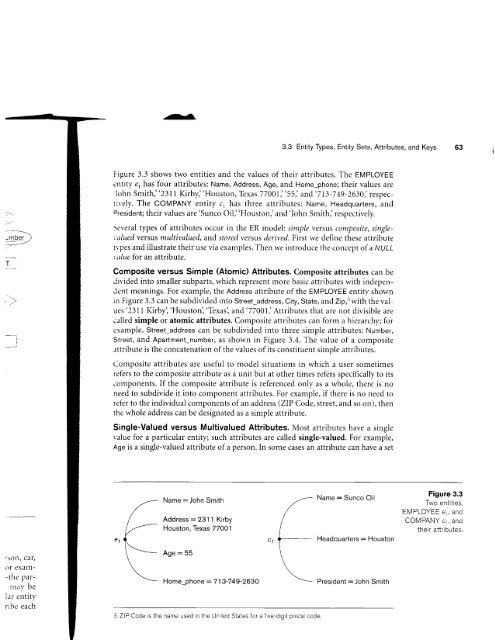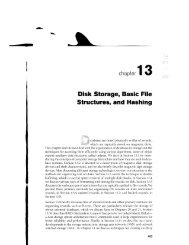this pdf excerpt
this pdf excerpt
this pdf excerpt
Create successful ePaper yourself
Turn your PDF publications into a flip-book with our unique Google optimized e-Paper software.
't<br />
---,--:-.:<br />
JmoeI<br />
-_==-?'<br />
T<br />
:5o11, car,<br />
or exam-<br />
-tlrc rrrr-<br />
nray be<br />
l.rr entity<br />
ribc each<br />
"d.<br />
3.3 Entity Types, Entity Sets, Attributes, and Keys<br />
Figure 3.3 shows two entities and the values of their attributes. The EMPLOYEE<br />
r'ntity el has four attributes: Name, Address, Age, and Home_phone; their values are<br />
'lohn<br />
Smith,''231I Kirby,''Houston, Texas 77001,''55,' and '713-749-2630,' respectively.<br />
The COMPANY entity c, has three attributes: Name, Headquarters, and<br />
Dresident; their values are'Sunco Oil,"Houston,'and'John Smith,'respectively.<br />
Several types of attributes occur in the ER model: simple versus composite, single-<br />
',dued versus multivalued, and stored versus derived. First we define these attribute<br />
tvpes and illustrate their use via examples. Then we introduce the concept of a N U LL<br />
', alue for an attribute.<br />
Composite versus Simple (Atomic) Attributes. Composite attributes can be<br />
Jivided into smaller subparts, which represent more basic attributes with independent<br />
meanings. For example, the Address attribute of the EMPLOYEE entity shown<br />
in Figure 3.3 can be subdivided into Street_address, City, State, and Zip,3 with the values<br />
'2311 Kirbyl 'Houston', 'Texas', and'77001.'Attributes that are not divisible are<br />
called simple or atomic attributes. Composite attributes can form a hierarchy; for<br />
crample, Street_address can be subdivided into three simple attributes: Number,<br />
Street, and Apartment_number, as shown in Figure 3.4. The value of a composite<br />
.rttribute is the concatenation of the values of its constituent simple attributes.<br />
Composite attributes are useful to model situations in which a user sometimes<br />
refers to the composite attribute as a unit but at other times refers specifically to its<br />
components. If the composite attribute is referenced only as a whole, there is no<br />
need to subdivide it into component attributes. For example, if there is no need to<br />
refer to the individual components of an address (ZIP Code, street, and so on), then<br />
the whole address can be designated as a simple attribute.<br />
Single-Valued versus Multivalued Attributes. Most attributes have a single<br />
r-alue for a particular entity; such attributes are called single-valued. For example,<br />
Age is a single-valued attribute of a person. In some cases an attribute can have a set<br />
Name: John Smith<br />
Address: 231 1 Kirby<br />
Houston, Texas 77001<br />
Age:55<br />
Home_phone : 7 1 3-749-2630<br />
3. ZIP Code is the name used in the Un ted States for a f ve-dioit oostal code<br />
Name: Sunco Oil<br />
Headquarters : Houston<br />
President: John Smith<br />
trn,4Dt .\vtrtr<br />
63<br />
Figure 3.3<br />
Two entities,<br />
^ ^^;<br />
Llvll LV I LL Cl I al lU<br />
COMPANY c,, and<br />
their attributes,














